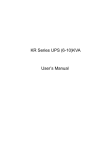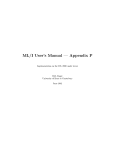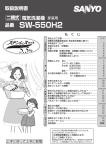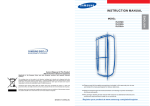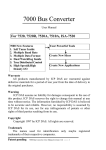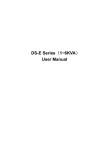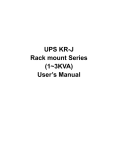Download DS-E Series UPS 10KVA User Manual - OPTI-UPS
Transcript
DS-E Series UPS 10KVA
User Manual
【NOTE】
Please carefully read the user’s manual before operation for the sake of
understanding correct operation of the instrument. Please keep the manual
handy for future reference.
WARNING
The input and output of the instrument is with danger high
voltages which may endanger the safety of life. Please strictly
follow the operating description is not allowed to remove the
cover of the instrument.
1.
2.
3.
4.
5.
Please connect protective earth before power supply cables.
The input & output voltage of the UPS is dangerous which will endanger the safety.
Dangerous voltages are present inside the unit. Please do not open the cover of the UPS.
Please turn off the mains input switch and the battery switch for any urgency.
There are many kinds of power sources in the equipment, the line bank or the socket may still
have dangerous voltage even if the main power is disconnected.
6. Please remove the cable between the battery & UPS before repairing. It’s necessary to wait for
another 5 minutes for discharging, because of the dangerous voltages.
7. The wires should be fastened to the terminals. It is prohibited to short the anode and cathode of
battery. It’s prohibited to touch any two of wire connectors or bare end of connecting wires.
Otherwise, it may lead to damage of battery or personal injury.
8. Please keep the battery away from the fire and all the equipment that may cause spark to
prevent the danger and damage.
9. Please do not open or shatter the battery, the overflow electrolyte is with causticity that may be
harmful to life.
10. Please contact the professional personnel of the local dealer or the special maintenance station
for any trouble-shooting. Random disposal of the trouble is not allowed.
11. This is an A-grade product with electromagnetic compatibility.
12. This equipment must be installed and serviced by qualified personnel.
13. Before usage, confirm that the temperature of the instrument has dropped into the normal run
range. It is recommended still placement for 24 hours in the normal temperature range before
startup.
14. Before you replace the battery of different brand and different type, make sure the charging
voltage is matching with UPS charging voltage due to the different required charging voltage of
different battery, If any doubt, please consult with the manufacturer. Any changes of the system
configuration, structure and composition will influence the performance of UPS, please consult
with the manufacturer in prior before doing any changes.
Index
1. Overview......................................................................................................................................1
1.1 Model Meaning Explanation ................................................................................................1
1.2 Abstract of Product ..............................................................................................................1
1.2.1 Product Feature.........................................................................................................1
1.2.2 Technical Specification ..............................................................................................3
2. Basic Principle and Structure....................................................................................................5
2.1 Principle...............................................................................................................................5
2.1.1 Principle Diagram ......................................................................................................5
2.1.2 Principle.....................................................................................................................5
2.1.3 Work Process ............................................................................................................6
2.2 Structure ..............................................................................................................................8
2.2.1 DS10000E Display Interface .....................................................................................8
2.2.2 DS10000E General Structure ....................................................................................9
2.2.3 DS10000E Line bar and Air-break Switch ...............................................................11
3. Transportation and Storage .....................................................................................................12
3.1 Transportation ...................................................................................................................12
3.2 Storage ..............................................................................................................................12
4. Installation.................................................................................................................................13
4.1 Installation Notice ..............................................................................................................13
4.2 Site and Environment Requirements .................................................................................14
4.2.1 Site Requirement.....................................................................................................14
4.2.2 Environment Requirement.......................................................................................15
4.3 Unpacking..........................................................................................................................15
4.4 Power Examination............................................................................................................16
4.5 UPS Installation .................................................................................................................16
4.6 Battery Group Installation ..................................................................................................16
4.6.1 Important Security Regulation .................................................................................16
4.6.2 Installation Process .................................................................................................16
4.7 Electrical Wire Connection.................................................................................................17
4.7.1 Switch Selection for Input ........................................................................................17
4.7.2 Selection of Input and Output Power Cord Diameter...............................................17
4.7.3 Mode of Single Unit Connection ..............................................................................17
4.7.4 Mode of Serial Hot Backup System .........................................................................19
4.8 System Examination ..........................................................................................................22
4.8.1 Electric Connection Examination .............................................................................22
5. Operation...................................................................................................................................23
5.1 Notice ................................................................................................................................23
5.2 Startup Preparation ...........................................................................................................23
5.2.1 Load Capacity Calculation.......................................................................................23
5.2.2 Checks before Power-on .........................................................................................24
5.3 Operation of a Single UPS.................................................................................................24
5.3.1 First Startup .............................................................................................................24
5.3.2 Daily Start-up and Shutdown ...................................................................................24
6. Maintenance Guard ..................................................................................................................25
6.1 Battery Maintenance..........................................................................................................25
6.1.1 Daily Maintenance ...................................................................................................25
6.1.2 Battery Changing.....................................................................................................26
6.2 UPS Maintenance Guide ...................................................................................................26
6.2.1 Safety Precaution ....................................................................................................26
6.2.2 Periodic Preventative Maintenance .........................................................................27
6.3 FAQ ...................................................................................................................................27
6.3.1 Abnormal Problem Analyses....................................................................................27
6.3.2 Troubleshooting .......................................................................................................30
6.3.3 Emergence Measure for Single System ..................................................................31
DS-E Series UPS 10KVA User’s Manual
1. Overview
1.1 Model Meaning Explanation
Model Meaning of UPS DS10000E
“DS10000E &
DS10KE31” means the product is high-frequency UPS of DS-E
Series. ”KE3” means that the phase of power input. “10KE31” means that the output
power is 10KVA with signal-phase.
1.2 Abstract of Product
1.2.1 Product Feature
DS10000E series UPS are on-line-UPS of sine wave charactering high-performance,
designed for network computer room, small intelligent equipments like measure devices or
industrial auto-machines etc. and exact instruments used in systems such as finance,
communication, insurance, railway, hospital, mine and enterprise etc, specially for terrible
electric network circumstance.
DS10000E series UPS, the on-line-UPS of sine wave charactering high-frequency has
mainly the following features:
& Great adaptability for power input
The input voltage range can be wide even to 120~276Vac, in which there is no need
for battery inversion that can availably protect batteries.
& Precise synchronization system with commercial power
The realization of exact zero-phase synchronization between output and input can
meet the requirement to synchronization of power supply and electric network from a
variety of instruments, being propitious to improve user system performance and
boosting the reliability of bypass switch.
& High input power factor
Adopt advanced active PFC technique, which alleviates load on electric network and
represents green power supply of new generation.
& High performance-price ratio
Adopt multiple power transfer and high frequency PWM technique, character high
efficiency, small size and light weight, improve running reliability and reduce
manufacturing cost. All above help decreasing customer cost of system designation.
& Low running input voltage
-1-
DS-E Series UPS 10KVA User’s Manual
Independent fast-test technique adopted leads to no inversion of DC/DC module even
when input voltage lows to limit 120V so that all the output energy under the
commercial supply status is transferred from electric network that can guarantee the
batteries are in 100% energy-storage status and decrease battery-discharge number
to prolong life.
& Perfect protection function
Functions designed such as output low-voltage protection, battery low-voltage
protection, current overflowing protection, fast current-limit, short-circuit protection etc
are able to avoid faults caused by manual operation mistake to guarantee reliable
work in different conditions.
& Intelligent RS232/485 communication (optional)
With RS232/485 standard data interface and dry-connector signal, supported by
UPSilon 2000 power monitor software, the status of electric network and UPS can be
directly inspected on the computer monitor. The product can also support KELONG®
SNMP network adaptor which will convert the UPS as fresh blood of network
immediately, realizing network administration and improving system reliability.
-2-
DS-E Series UPS 10KVA User’s Manual
1.2.2 Technical Specification
Table 1-1DS-E Series 10KVA Technical specification
Model
Index
Input Characteristic
Rating
(V)
Rating
frequency (Hz)
Phase
Output Characteristic
----------------
DS10KE31
45-55/55-65 (setup when leaving factory)
Three-phase five-line
voltage
240
Capacity (VA)
10000VA/7000W
Voltage (V)
230±2%
Frequency (Hz)
DS10KE31L
120~276Vac half full load
150~276Vac 75% full load
176~276Vac 100% full load
1﹑In condition without one of U and V
phase ,the other two phase voltage between
176-276V ,UPS working with half load . The
other two phase voltage between 120-176V,
UPS working with 25 percent load.
2﹑In condition without U and V phase ,the
other two phase voltage between
176-276V ,UPS working with 25 percent
load . The other two phase voltage between
120-176V, UPS working with 13 percent
load..
Single-phase three-line
50 or 60±0.1%(battery mode)
Waveform
Sine wave, THD < 3% (Linear load)
Switching
time(ms)
0
Overload
capacity
105%-130% rating load ,last 10min then turn into bypass
131%-150% rating load ,last 1min then turn into bypass
Above150% rating load ,last 1 sec then turn into bypass
Output mode
Line bar
Spare time
Optional
Charge recovery
time
Communication
interface
Other Characteristic
DS10000EL
voltage
Working without
other phase
Battery
(V)
DS10000E
Warning function
Panel display
Audio-noise
(dBA)
Protection
function
Working
temperature
Relative
humidity
<24 小时(100AH a group)
RS232 interface supports UPS power management software and SNMP protocol
Incorrect connection of phase-sequence
to input , Battery low voltage protection,
Commercial power abnormal, UPS fault
Battery low voltage protection, Commercial
power abnormal, UPS fault
LED displays operation status and parameter of UPS
<65
Battery low-and-over-voltage protection, overload protection, short-circuit protection and
excess temperature protection
0~40℃
0~95%,No condensation
-3-
DS-E Series UPS 10KVA User’s Manual
Size (mm)
(W × D × H)
253×637×500
253×637×680
253×637×
500
253×637×680
Weight (Kg)
29
80
30
81
◆ Specifications are subject to change without prior notice.
-4-
DS-E Series UPS 10KVA User’s Manual
2. Basic Principle and Structure
2.1 Principle
2.1.1 Principle Diagram
230Vac
PFC AC/DC
DC/AC
SW
LOAD
DC/DC
CHARGE
BATTERY
Fig.2-1 DS10000E Principle Diagram
2.1.2 Principle
UPS DS10000E is made up of PFC, AC/DC (Commercial power rectification and boost
circuit), DC/DC (battery voltage-boost circuit), DC/AC inverter, switch, charger and
battery group etc.
When commercial power is normal, through PFC, it can be boosted to ±350V stabilized
DC supplied for DC/AC inverter to output steady 230V AC and finish battery charge at
the same time. When commercial power is abnormal, through DC/DC, the battery
voltage will be increased to ± 350V DC supplied for DC/AC inverter. Because of PFC and
power-down fast-test technique adopted, even when the commercial power voltage lows
to limit 120V, the battery group can still have no output current to assure battery longevity
and be kept in energy-storage status and if commercial abnormal battery voltage-boost
will start up at once to assure steady DC/AC output.
As information shown in the figure above, the DC/AC inverter adopts half-bridge structure,
DC/DC module uses boost-circuit, PFC is active power-factor correction circuit controlled
by UC3854 and CHARGER is a kind of complete isolation charger.
-5-
DS-E Series UPS 10KVA User’s Manual
2.1.3 Work Process
When 230Vac normal, main DC circuit has DC voltage supplied for DC/AC AC-inverter
which outputs stable 230Vac and charges battery at the same time. Whenever
commercial power was low or broken down suddenly, the battery group would feed back
electric power to DC circuit through DC/DC voltage-boost module until its energy used up.
At the moment UPS would send out audio-light warning till battery voltage drop to the
discharge limitation point then UPS would stop inversion and emit lasting sound. In
addition, UPS has overload protection. When overload (125% full load) happens, UPS
would turn to bypass supply and return if load recovers normal. When more serious
overload (over 150% full load) appears, UPS would halt inversion and switch to bypass
supply-at the time the switch may have jumped. After fault of load eliminated, as long as
turn on the switch, UPS will restart to work again.
Audio-light warnings will always go with UPS when UPS abnormal. The warnings or
protections are shown in detail in Table 2-1.
Table 2-1 The function of abnormal status and warning
Protection
UPS Status
Beep
Indicators On Panel
LCD Display
/Warning
INV. On, Line on, Bypass off,
Normal
“Output Voltage
No beep
No
Fault off, Output on
230.0 V ”
Turn to
Once every 1.5
INV. On, Bypass off, Fault off,
sec
Output on.
“Output 230.0V
105% overload
bypass supply
OVERLOAD ”
in 10 min
Turn to
Bypass on, INV. Off, Fault on,
125% overload
“Output 230.0V
Long beep
bypass supply
Output on in 1 min
OVERLOAD ”
in 1 min
INV. Off, Bypass on, Fault on,
150% overload
“Output 230.0V
Protected
Long beep
Output on
LOAD PROTECT”
Once every 0.5
INV. On, Line off, Bypass off, Fault “Output 230.0V
sec
off, Output on
Waning
Low-voltage point
BAT. LOW ”
Battery voltage
INV. Off, Line off, Bypass on,
below protection
“Output 230.0V
Protected
Long beep
Fault on, Output off.
BAT. PROTECT”
point
UPS not wired to
INV. On, Line off, Bypass off,
“Output 230.0V
No beep
battery
No
Fault off, Output on
Input breaker
Three beep with
cutoff or input
100ms interval
INV. On, Line off, Bypass off,
“Output 230.0V
Warning
Fault off, Output on
abnormal
BAT. FAIL”
every 10 sec
-6-
LINE FAIL”
DS-E Series UPS 10KVA User’s Manual
INV. Off, Line off, Bypass on,
Over temperature
“Output 230.0V
Long beep
Protected
Fault off, Output on
OVER TEMP”
Output
over-voltage,
INV. Off, Bypass on, Fault on,
Long beep
UPS FAIL”
Output on
Output
“Output 230.0V
Protected
low-voltage
INV. Off, Bypass on, Fault on,
Short-circuit
“Output 230.0V
Long beep
Protected
Output on
OUTPUT SHORT”
Note: If commercial power recovers after low-voltage protection to battery, the product
will restart and charge batteries.
-7-
DS-E Series UPS 10KVA User’s Manual
2.2 Structure
2.2.1 DS10000E Display Interface
④
BYPASS
①
INPUT
LINE
⑥
②
INV.
③
OUTPUT
⑤
⑦
FAULT
ON ⑧
SELECT
OFF ⑨
Fig. 2-2 DS10000E Display Interface
Illustration:
① “LINE”
②
③
④
⑤
⑥
⑦
⑧
⑨
: When commercial power is normal, light on, abnormal off. When reverse
connection of “L” and “N”, light glittering.
“INV.”
: Inverter normal, light on, abnormal off.
“OUTPUT” : UPS has output, light on; no output off.
“BYPASS” :UPS in status of bypass supply, light on; in status of inversion, off.
“FAULT” :UPS fault, light on; normal, off;
LCD Display
:Select” : When UPS normal, LCD displays normal output voltage. If the button pressed, the
background light on and the LCD display will show input voltage, input frequency,
output power, UPS status etc. In addition, when in battery inversion model, press
the button for 2 sec, the interval beep can be cancel but warning audio in the
status like battery low-voltage etc.
“ON”
:When UPS is shutdown, press the button for 2 sec, UPS starts up. When UPS is
running, press the button for 2 sec, UPS will enter battery test model. When
battery voltage reaches the low-voltage point or test time last 10 sec, UPS will stop
the function.
“OFF”
:When UPS is running, press the button for 2 sec, UPS will shut down.
-8-
DS-E Series UPS 10KVA User’s Manual
2.2.2 DS10000E General Structure
⑤
DISPLAY
BYPASS
②
⑦
③
INPUT
LINE
INV.
OUTPUT
⑥
ON ⑨
⑧
FAULT
RS232/485
RS232/485
INERTFACE
④
①
SELECT
OFF ⑩
FANS
AIR
INLET
POWER
NFB1
ON
BATTERY
NFB2
LINE SWITCH
OFF
BATTERY
SWITCH
LINE BAR
COVER
Fig.2-3 DS10000E Front Panel and Rear Panel
⑤
DISPLAY
BYPASS
②
⑦
③
④
①
INPUT
LINE
⑥
FAULT
INV.
OUTPUT
⑧
ON ⑨
SELECT
RS232/485
INERTFACE
RS232/485
OFF ⑩
Fan
AIR
INLET
FANS
POWER
LINE SWITCH
ON
BATTERY
OFF
BATTERY
SWITCH
LINE BAR
COVER
Fig.2-4 DS10000EL Front Panel and Rear Panel
-9-
DS-E Series UPS 10KVA User’s Manual
⑤
DISPLAY
⑦
BYPASS
②
③
④
①
INPUT
LINE
INV.
OUTPUT
⑥
ON ⑨
⑧
FAULT
RS232/485
INERTFACE
RS232/485
SELECT
OFF ⑩
Fan
AIR
INLET
市电
电池
BATTERY
POWER
NFB1 开/ ON NFB2
Fan
LINE SWITCH
BATTERY
SWITCH
关/ OFF
AIR
INLET
LINE BAR
COVER
Fig.2-5 DS10KE31 Front Panel and Rear Panel
⑤
DISPLAY
BYPASS
②
⑦
③
④
①
INPUT
LINE
⑥
FAULT
INV.
OUTPUT
⑧
ON ⑨
RS232/485
INERTFACE
RS232/485
SELECT
OFF ⑩
Fan
AIR
INLET
市电
电池
BATTERY
POWER
NFB1 开/ ON NFB2
Fan
LINE SWITCH
BATTERY
SWITCH
关/ OFF
AIR
INLET
LINE BAR
COVER
Fig.2-6 DS10KE31L Front Panel and Rear Panel
- 10 -
DS-E Series UPS 10KVA User’s Manual
2.2.3 DS10000E Line bar and Air-break Switch
OUTPUT
BATTERY
+
-
L
DC input
N
AC output
PE
INPUT
N
N
L
AC input
BY
BYPASS
L
Grouding Bypass
input
N
L
Bypass
source
Fig. 2-7 Line Bar of DS10000E
DC input
AC output
Grouding
AC input
Bypass
input
Fig. 2-8 Line Bar of DS10KE31
BATTERY
POWER
ON
LINE Switch
OFF
Battert Switch
Fig. 2-9 DS10000E Air-break Switch
BATTERY
POWER
ON
LINE Switch
OFF
BATTERY Switch
Fig. 2-10 DS10KE31 Air-break Switch
- 11 -
DS-E Series UPS 10KVA User’s Manual
3. Transportation and Storage
3.1 Transportation
During the portage, do strictly comply with the caution brands on the packaging carton to
handle the UPS with care and place it in the correct direction to avoid the oscillatory device
damage. It is prohibitive that the UPS is positioned in the open car or cabin, mixed with
flammable and explosive commodities, parked in open air during the transshipment. No
raining, snow or liquor straining and mechanism shattering.
3.2 Storage
The location direction should accord with what shown on the package when the equipment
is been stored. The package carton should be blocked up about 20cm and laid at least
50cm away from the wall、heat source、cold source、windows or air entrance.
Keep equipment in dry storage, and prohibit isolation and raining. There should not be
kinds of malfeasance gas, flammable, explosive and corrupting chemical material and
strong mechanism shock, concussion and strong magnetic field in stocking room. The
temperature for UPS storage is 0~40℃。The storage humidity is 20%~80%. The storage
period should be 6 months except other regulation. Recheck if the period exceeds 6
months.
- 12 -
DS-E Series UPS 10KVA User’s Manual
4. Installation
4.1 Installation Notice
1.
Before the UPS installation, check if the feeding circuit of electric network is clear,
including contacts of all the connection points and the sockets are OK, so as to avoid
open circuit or short circuit.
2.
For the input one-phase-three-lines system, do pay attention to whether the
grounding is good and ensure the voltage between zero line and grounding line is less
than 5V. If the grounding line is null, the voltage could be 100V. If the user load has
strict requirement to voltage between the zero line and the grounding line of the power
supply, make sure the grounding of the mains supply is good so as to avoid
unnecessary loss.
3.
When you are installing UPS, do not reversely or wrongly connect the zero line、
caustic line and grounding line of the UPS input and output so as to avoid short circuit
and check out if the voltage of the mains supply is normal.
4.
If battery group installed for long spare time, do strictly accord with connection method
and sequence prescribed by the installation manual to wire and the wiring must be tie
tightly. Short-circuit to the polarities of battery and simultaneous touch with any bare
party of any two terminals or wire are strictly forbidden or that would result in battery
damage or even person injury. When battery group connected to UPS, check if the
voltage of battery group coincides with that demanded by UPS.
5.
The UPS installation requirement:
Lie UPS on the flat ground (avoid sloping and scabrate ground).
Do not place goods on the UPS nor do the person sitting.
Avoid place such as sunlight、rainy and moist location.
Avoid place where erosive gas included in the air.
- 13 -
DS-E Series UPS 10KVA User’s Manual
Fig.4-1 UPS placement
4.2 Site and Environment Requirements
4.2.1 Site Requirement
1.
Cleanness
Do not stack sundries and rubbish around the UPS. Unfortunate drop or place of the
globule or metal may result in the short circuit which is dangerous to the system and
human life security. The dust or sundries in the exhaustion vent may get in the way of
air circulation even affect the cooling of the fans, which will result in the system
shutdown cause of over-temperature. The civil engineering construction of the
equipment room should be completed totally with the floor sclerotic and tidy dry
dust-free site.
2.
Fire control
Strictly prohibit the storage of flammable explosive and dangerous commodities in the
equipment room.
To lower the feasibility of fire and the damage resulted from it, in the room where UPS
placed, there should be the fireproof material used to the wall、cell and ground and
serviceable and valid fire protection equipments configured such as portable CO2
extinguisher.
3.
Ventilation and heat emission
For the convenience of the operation maintenance and the heat emission of the
equipment, there should be clearance about 30~50cm around UPS and 50cm above
the top. Exhausting fans should be installed beside the batteries, which have longest
- 14 -
DS-E Series UPS 10KVA User’s Manual
usage under the common temperature(20°C), to keep the good ventilation of the
room.
4.2.2 Environment Requirement
Ambient temperature: 0℃~+40℃;
Relative humidity: 0%RH~95%RH, no condensation;
Cooling mode: air cooling;
Altitude: meet GB/T 7260.3-2003;
Verticality: no shock with orthogonal rake not exceeding 5;
Pollution rank: Class Ⅱ;
The UPS should be installed in the environment where exist enough ventilation, the
cool clear air, not too high humidity and no dust. The recommended work temperature
is 20~25℃ and the humidity should be controlled around 50%.
Note: Strictly forbid the installation in the environment with dust of metal
conduction.
4.3 Unpacking
The UPS and accessories, packaged in carton or wooden crate and carton, should be
carefully unpacked and checked whether all are ready or were damaged during the
transportation, according to the package list. Make sure that all the accessories have
been found before package material cleanliness.
Any emergence, that equipment or some accessory damaged during the
transportation or not according with the contact, should be recorded on the spot and
reported immediately to the local branch or office.
Check if there is mechanical damage resulting from the transportation when the new
product unpacked. If serious damage to appearance have been found, do the further
examination.
- 15 -
DS-E Series UPS 10KVA User’s Manual
4.4 Power Examination
Before installation, make sure load capability of electric network satisfies the new
equipment requirement and the power accords with the voltage and frequency on the
nameplate, if current carrying capability declined cause of the aging of lines. If any
doubt, please negotiate the solution with the local mains supply department.
4.5 UPS Installation
Move UPS from carton or wooden crate to the selected location.
4.6 Battery Group Installation
4.6.1 Important Security Regulation
No unclenching or detaching battery, because of that would result in injury to person
skin and eye by electrolyte inside them. To avoid electric shock or short-circuit, the
following precautions should be strictly complied with when battery changed:
1.
No watch, ring or other metal accouterment wore;
2.
Use tools with isolated handle;
3.
No placement of tools or metal on the battery;
4.
No fire is close the battery and no smoking.
4.6.2 Installation Process
1.
To achieve safe operation and avoid unnecessary harm to the UPS, all the
assembly of outer-placed battery should be executed by the professional
technicians and follow the manipulation sequence below:
a)
Complete the wiring among the outer-placed battery groups but temporarily
do not connect them to the terminals of UPS.
b)
Connect the input power cable to UPS assuring that the polarity and input
voltage accord with the specification.
2.
Under the status that the AC input is normal and UPS has no load, turn on the
main switch to measure the DC voltage of terminals for outer-battery connection.
3.
If the result, gained from step 2, called charge voltage is normal, then connect the
outer-placed battery group to UPS. At the moment, confirm that the connection
polarity is correct.
- 16 -
DS-E Series UPS 10KVA User’s Manual
4.
After assembly and test finished, the UPS can be put into use.
4.7 Electrical Wire Connection
4.7.1 Switch Selection for Input
Before the input coil in of the equipment, install an air switch or a distribution box
compliant with the power and capability of the equipment, to isolate it with commercial
power. Consider especially the charge power and the current shock, the input air
switch can be higher than 1.5-2 times most current of UPS input, which is without
creepage protection in order to avoid error action. The distribution box should be
better to be manufactured by professional company. Please refer to Table 4-1.
Table 4-1 Recommended Sectional input air switch
DS10000E、DS10KE31
Max. Current(A)
AC Input
DC Input
Recommended Air switch(A)
78
100
55
100
4.7.2 Selection of Input and Output Power Cord Diameter
For the selection of conducting wire sectional area for UPS AC input and output cable
and battery cable, please refer to Table 4-2 for corresponding recommended values,
and choose values upwards.
Table 4-2 Recommended Sectional Flow of Cable Sectional Area of UPS(mm2)
DS10000E DS10KE31
AC Input(”L” and “N”)
10
10
AC Input(Grounding)
4
4
DC Input(”+” and “-”)
10
10
AC Output(”L” and “N”)
10
10
The cable areas above are just the reference for about 5-meter-long line for user. And
if the line is longer than 20 meters, the area should be a little larger.
4.7.3 Mode of Single Unit Connection
Insert and screw tightly the going-with power cable and wire into sockets and
terminals of the line bar
Note: When wire connected, make sure that the wires and terminals of input
and output should be contacted reliably, no disqualified contact and reversed
wiring.
- 17 -
DS-E Series UPS 10KVA User’s Manual
4.7.3.1 DS10000E Connection
DS10000E adopts line bar for input and output wiring. Firstly disassembly cover
protecting line bar to connect wire. After connection completed, please check if the
cables for wiring are correct and firm. If all is right, assembly the cover back to UPS.
The cable connection is shown in Fig.4-2 and 4-3 .
BATTERY
+
-
OUTPUT
L
N
INPUT
N
PE
L
BY
BYPASS
N
L
N
L
Short-connection-wire
(connected befor leave factory)
(240VDC)+
-
Bypass "L"
AC Output "L"
AC Output "N"
Bypass "N"
Grounding
AC Input "N"
AC Input "L"
Fig.4-2 DS10000E Mode of Connection
BATTERY
+
-
L
N
PE
INPUT
OUTPUT
N
U
V
W
BYPASS
N
L
Short-connection-wire
(connected befor leave factory)
+
(240VDC)
-
Bypass "L"
AC Output "L"
AC Output "N"
Bypass "N"
Grounding
AC Input "N"
AC Input "L"
Fig.4-3 DS10KE31 Mode of Connection
- 18 -
DS-E Series UPS 10KVA User’s Manual
4.7.4 Mode of Serial Hot Backup System
4.7.4.1 Connection Procedure
1
First pick off the line bar of main UPS and standby UPS, then remove the side sheet.
2
Remove the line that connect the “L” in the bar signed “BYPASS” and the “L” in the bar signed
“BY”.
NOTE: In three-phase five-line UPS should remove the line that connect the “JP15
(LIN)” in the printed plate signed “TK1110R-GF03” and the “L” in the bar signed
“BYPASS”
3
Connect the “L” in the main UPS bar signed “BYPASS” and the “L” in the standby UPS bar
signed “OUTPUT” with red line; Connect the “N” in the main UPS bar signed “BYPASS” and the
“N” in the standby UPS bar signed “OUTPUT” with blue line;
NOTE: Do not connect “L” with “N”
4
The other connection procedure the same with single unit.
5
Make sure the connection is correct and then fix the decking of the line bar
4.7.4.2 Connection Way
1
DS10000E line connection for the serial hot backup system. the connection is shown in Fig.4-4
2
DS10KE31 line connection for the serial hot backup system. the connection is shown in Fig.4-5
- 19 -
L
N
AC Output "N"
AC Output "L"
BATTERYBATTERY+
L
N
PE
L
AC Input "N"
+
-
L
N
AC Input "L"
OUTPUT
INPUT
BYPASS "N"
N
BYPASS "L"
GND
BATTERY
Standby UPS2
BYPASS
N
BY
L
Connected befor
delivery
BATTERY
+
L
N
AC Input "N"
L
N
PE
INPUT
AC Input "L"
OUTPUT
GND
-
Mains UPS1
BYPASS
N
BY
L
Remove
DS-E Series UPS 10KVA User’s Manual
BATTERYBATTERY+
Fig.4-4 DS10000E Cable Connection for the serial hot backup
- 20 -
L
N
W
V
AC Input "V"
U
AC Input "U"
N
AC Input "N"
N
AC Output "N"
AC Output "L"
BATTERYBATTERY+
L
BYPASS "L"
N
BYPASS "N"
W
V
AC Input "V"
U
AC Input "U"
AC Input "N"
-
L
N
AC Input "W"
N
GND
BATTERY-
+
BATTERY
OUTPUT
INPUT
Standby UPS2
PE
BYPASS
Connected befor
delivery
-
AC Input "W"
L
GND
+
BATTERY
OUTPUT
INPUT
Mains UPS1
PE
BYPASS
Remove
DS-E Series UPS 10KVA User’s Manual
BATTERY+
Fig.4-5 DS10KE31 Cable Connection for the serial hot backup
- 21 -
DS-E Series UPS 10KVA User’s Manual
4.8 System Examination
4.8.1 Electric Connection Examination
1
AC input wires examination: check if the colour is normative, the size is proper, the wires have
connected to outside control switches, the connections of the caustic line(L), zero line(N),
grounding wire(GND)are correct and wire connections are firm.
2
AC output wires examination: check if the colour is normative, if the size is proper, if the wires
have connected to outside control switches, if the connections of the caustic line(L), zero line
(N), grounding wire(GND) are correct and if wire connections are firm.
3
The grounding wire examination: check if the grounding wire of the UPS connected to the
collecting bar in the apparatus room and the connection is reliable.
4
Voltage which below 5V between the zero wire and the grounding wire examination.
5
If the UPS has installed remote monitor device, check if the correlative connection of the
RS232 serial-port is correct.
6
Check if the wiring is regular, cable binding accords with the technical criterion.
7
Check if the installation and wiring is good for the further development, proliferation and
maintenance.
- 22 -
DS-E Series UPS 10KVA User’s Manual
5. Operation
5.1 Notice
1.
Before the UPS startup, check if the load is proper, which should not exceed the
rated power or the status overload protection or all time bypass power supply of
the UPS will be brought about.
2.
Do not use the switch on the UPS panel as the power switch of the load
equipment and strictly refer to the follow sequence to turn on or off the UPS:
when startup, firstly turn on the switch on the UPS panel then the equipment’s.
When shutdown, firstly turn off the switch of the equipment then the UPS. Avoid
the frequent startup.
3.
Till the UPS startup into steady work status, turn on the load equipments with
high-power ones first and low power ones later because the startup current of
some equipments are large enough to result in over-load protection (or bypass
protection). So it is advisable equipments of this kind should be started up before
the others.
4.
When the UPS connected to the generator necessary as the mains supply cut off,
firstly start the generator, and then switch in the UPS till the generator on steady
work status or the UPS or the load equipments may be damaged. In a similar way,
disconnect the UPS and the generator before the generator turned off.
5.2 Startup Preparation
5.2.1 Load Capacity Calculation
DS10000E calculates load capacity based on 70% resistance load of nominal rated
power. Usually the largest bearable computer load number N is calculated according
to the following formulae:
n
∑Pi≤P
i=1
In the equation, P stands for UPS output capacity (VA), Pi is VA of No. i load.
- 23 -
DS-E Series UPS 10KVA User’s Manual
5.2.2 Checks before Power-on
1.
Make sure there is no mistake of the input and output installation.
2.
All the breakers are pulled on the “OFF” status.
3.
Connect the input terminals to the rated power.
4.
Make sure that there is no short-circuit to the UPS output and load capacity does
not exceed that of the UPS.
5.
Make sure computers or other instruments are off.
5.3 Operation of a Single UPS
5.3.1 First Startup
After confirming all the above, please start the machine by following means:
1.
Press “ON” button on the UPS and UPS will slowly startup with indicator
“INV.” on. In a while, indicator “BAPASS” will go off then UPS will turn into
inversion power supply model. At the moment UPS startup completed.
2.
Turn on load like computer or other equipment.
5.3.2 Daily Start-up and Shutdown
During daily operation, operate as per the following for start-up or shut down:
1.
Press the "ON" button on the UPS panel to start UPS, after 20 seconds, turn
on the computer or other instrument.
2.
Normally, only when the UPS has been started and is working stably, can the
loading equipment power switch be turned on. First turn on high-power
equipment, then the equipment with lower power.
Some equipment has
large start current (such as monitors of some brands). When starting such
equipment, overload protection (such as bypass operation) may occur.
In
this case, it's recommended to start this type of equipment before other
equipment.
3.
Before shutdown, turn off the computer and other instrument first. Then
press the "OFF" button on the panel for 2 seconds.
- 24 -
DS-E Series UPS 10KVA User’s Manual
6. Maintenance Guard
6.1 Battery Maintenance
6.1.1 Daily Maintenance
1.
If the equipment has not been used for a long period, start UPS every month to
charge battery for more than 4 hours each.
2.
Before UPS use, please start up UPS to charge battery for 4 hours, during which
UPS can be still useful. But if there is accidence of power broken-down, the
discharge period this time will be below standard time.
3.
Normally, battery will be charged and discharged every four to six months. First
discharge until shutdown then charge. The charging time for standard device
should be no less than ten hours each time.
4.
At high temperature region, the battery should be charged and discharged once
every two months.
The charging time for standard device should be no less
than ten hours each time.4.
5.
Batteries of different capacity, type, and produced by different manufacturers
should not be mixed when using.
6.
When cleaning battery case, only use wiping cloth and clear water, do not use oil
substance or organic solvent such as gasoline and thinner, etc.
7.
Battery and battery unit should be kept away from ignition source as well as all
electrical equipment that may easily cause spark, to avoid causing unnecessary
loss.
8.
During the use of battery unit equipped for UPS, regularly check if the charger is
in good condition to prevent the battery from being overcharged or undercharged
for a long time, and to avoid excessive discharge of battery. After discharging,
immediately (no later than 24 hours) perform complete charging, only after then
will the re-discharged be allowed. Never re-discharge if the battery is not
completely charged, otherwise it will cause decrease in battery capacity or even
damage to battery.
9.
When not using UPS, please turn off the "OFF" switch on the panel to avoid
causing long-time battery discharge after commercial power failure.
If the UPS
has not been used for a long time, regularly perform charging and discharging of
battery to avoid battery damage due to self-discharging.
- 25 -
DS-E Series UPS 10KVA User’s Manual
6.1.2 Battery Changing
1.
Do not throw battery into fire to avoid explosion.
2.
Do not open or disassemble battery as the electrolyte is harmful to skin and eyes.
3.
Properly recycle the battery according to relevant instructions thereon.
4.
Replace the used battery with new ones that are of same type and grade.
5.
Replace the entire battery unit, do not mix the old ones with the new ones.
6.
Dangerous voltage may exist between battery terminal and the ground. Test
before touching.
6.2 UPS Maintenance Guide
The correct maintenance, including the preventative maintenance and remedial
maintenance, is the key to the best operation and longer usage life of the UPS. The
preventive maintenance includes some regular programs to avoid the faults of the
power system and reach maximum efficiency. The remedial maintenance includes the
probing of the power system fault for the effective maintenance.
6.2.1 Safety Precaution
For safe and smooth maintenance on the power system, you must follow the related
safety precautions, prepare the necessary gears and testing equipments and operate
under the eligible maintainer’s control. Pay attention to the following safety operation
regulations:
1.
Do remember there always exist hazardous voltage inside UPS even when
UPS do not run.
2.
Make sure persons manipulating or maintaining UPS are familiar with the
manual and instrument.
3.
When UPS operation, no golden or sliver accouterments like ring, watch
wore.
4.
Do assume the safe operation procedure as a matter of course. If any doubt,
consult with persons being familiar with the instrument.
5.
Keep eye on the hazardous voltage inside the UPS every moment. Using
voltmeter to check if the input power is completely cutoff and in safe status
before maintenance and adjustability.
6.
Please comply with the manual to use UPS. When UPS faults, please cut off
- 26 -
DS-E Series UPS 10KVA User’s Manual
the connection between battery cabinet and UPS immediately then deliver it
to professional maintainer or station. Self-deal is prohibited.
6.2.2 Periodic Preventative Maintenance
To improve the efficiency and reliability of the UPS power system, please complete
the following preventative maintenance operations:
1.
Keep environmental cleanliness to avoid the dust or chemical pollution to the
UPS.
2.
Examine the input and output terminals every half year to ensure the good
contacts.
3.
Examine periodically fans working status to prevent sundries to plug up the
ventilation. If any damage, please change at the time.
4.
Examine periodically the UPS work status.
6.3 FAQ
6.3.1 Abnormal Problem Analyses
If the UPS fails to work properly after starting, please don't jump to the conclusion of
UPS failure. Please refer to the following and try to solve the problem.
Problem 1
Power supply is normal; UPS is able to output AC 230V after start, yet in the
status of battery inversion.
Possible cause:
Unstable AC power input as a result of poor contact of the junction points,
sockets or other connection parts of the electric network feeder circuit connected
to the UPS.
Problem 2
After UPS is installed, and after the electric brake or UPS "ON" button is switched
on, the fuse will be burnt out or tripping occurs.
Possible cause:
wrong connection of three UPS input wires, for example, zero line or fire wire is
connected to UPS earth wire (case); or wrong connection of three UPS output
wires.
- 27 -
DS-E Series UPS 10KVA User’s Manual
Problem 3
After UPS is started, it outputs AC 230V, yet it's working under bypass status
("BYPASS" keeping lighted).
Possible cause:
Too-heavy load sustained by the device which exceeds rated power of the UPS.
In such cases, relieve the load to the UPS, or use a UPS of higher rated power
capacity. If it is a temporary bypass status caused by start-up impact of the load,
and returns to proper status automatically, that's normal operation.
Problem 4
Display and output of the UPS are normal after start. However, the output stops
as soon as load is connected to it with “INV.” indicator off, “BYPASS” on.
Possible cause:
UPS overload severely or output short circuit. Reduce the load to an adequate
amount, or check the cause for short circuit. In many cases, it is caused by output
adapter short circuit or input short-circuit fault owing to equipment damage.
Problem 5
UPS works properly after start-up, and automatically shuts off after a certain
period of time.
Possible cause:
Battery group is not charged in time and is working under battery supply status
(not powered or not connected to power grid), thus resulting in battery
low-voltage protection of the UPS.
Warning: in the case of UPS battery low-voltage protection, please immediately
turn off all switches, and restart the UPS and charge the battery to full capacity
when power supply recovers. Long-period low-voltage of the battery will shorten
the service life of the battery.
Problem 6
After working for a certain period, with normal input display, the buzzer gives
intermittent buzzing and displays battery low-voltage simultaneously.
Possible cause:
AC input voltage is too low, below 120V, to make the UPS work turn into battery
inversion model which causes battery low-voltage protection when battery energy
used up. It is proper to adopt some way like adding previous AC regulator to
increase AC voltage in the acceptable range by UPS.
- 28 -
DS-E Series UPS 10KVA User’s Manual
Problem 7
UPS is started and working. When power supply breaks down, UPS fails to
output power.
Possible cause:
The battery group is not connected to main unit or is severely damaged.
- 29 -
DS-E Series UPS 10KVA User’s Manual
6.3.2 Troubleshooting
6.3.2.1 Overview
In the case of device failure, first of all, find out any obvious damage and try to
determine what causes the failure: device problem or external environment (such as
temperature, humidity and load). Always check these external factors before coming
to the conclusion of UPS system damage.
6.3.2.2 Troubleshooting
Only some simple troubleshooting suggestions are provided here. If the diagnosis
result is not certain or the information given here is not sufficient for problem-solving,
please turn to your local office or distributor for repair.
1.
Buzzer gives long buzzing, “FAULT” light is on, UPS is powered through
bypass, and inverter fails.
Possible cause:
① Output overload or short circuit results in UPS automatic shutdown
protection;
②Driving or power tube malfunction;
③UPS Over-temperature protection;
④Master control board failure.
2.
UPS works properly when power supply is O.K., but it fails to function during
power failure.
Possible cause:
①Battery failure.
②Battery charger malfunction: Fail to charge battery when power supply is
O.K.
3.
Intermittent buzzing of the buzzer when UPS input is normal.
Possible cause:
The voltage from commercial supply is too low, below 120V.
4.
UPS works well when computer is in operation. After power failure, UPS
works properly and the computer breaks down.
Possible cause:
Poor grounding connection as a result of much too high float-charge voltage
- 30 -
DS-E Series UPS 10KVA User’s Manual
of the zero line and earth wire.
5.
All of panel indicator lamps are off.
Possible cause:
Poor connection or malfunction of display control panel.
6.
UPS is normal with no load but it faults once it start up with load, turning into
bypass power supply.
Possible cause:
Maybe one of IGBT driver signal lost.
6.3.3 Emergence Measure for Single System
In case of fault appearing in the single system, press “OFF” on UPS panel to shut
down UPS. If necessary, cut off user load and switch of input and output to protect
UPS from further damage.
- 31 -




































